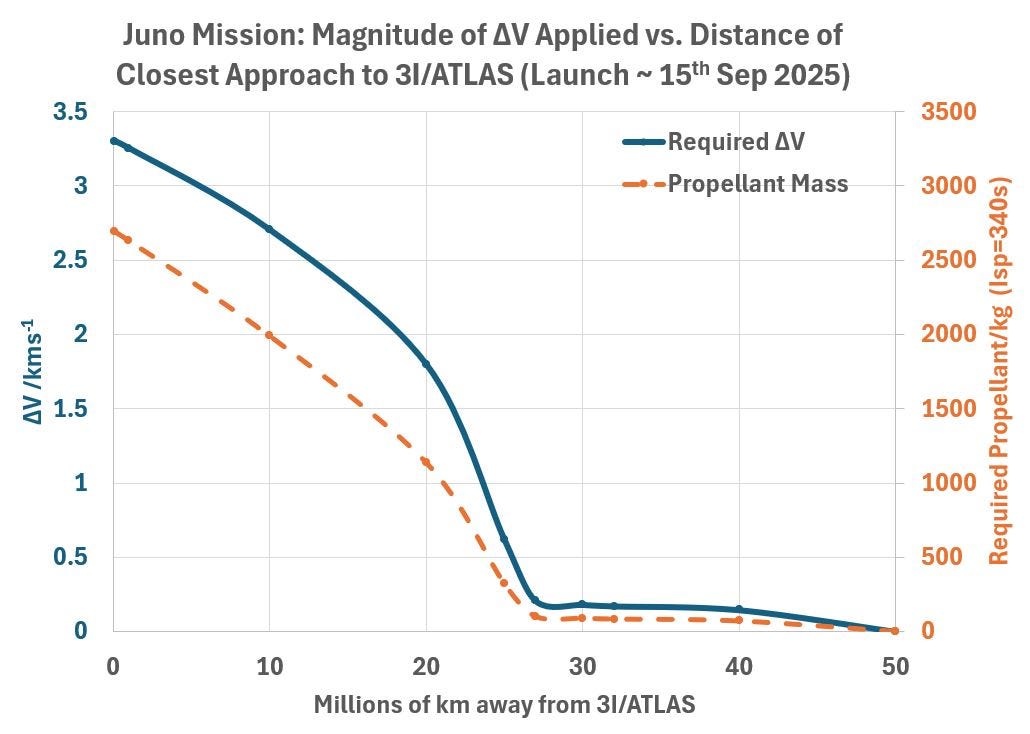
How Close Can the Juno Spacecraft Get to the Interstellar Object 3I/ATLAS?
How did your country report this? Share your view in the comments.
Diverging Reports Breakdown
How Close Can the Juno Spacecraft Get to the Interstellar Object 3I/ATLAS?
How close can Juno get to the Interstellar Object 3I/ATLAS as a function of the available fuel mass? Avi Loeb: This question became timely after a phone call that I received from Congresswoman Anna Paulina Luna. The next step is for NASA to assess the remaining amount of fuel left in Juno’s engine. Once the fuel reservoir is known, it would be possible to optimize the timing for applying thrust impulses. The resulting benefits to space science will be great and to our understanding of our place in our cosmic neighborhood, Loeb says. He is the head of the Galileo Project, founding director of the Black Hole Initiative at Harvard University and a co-author of “Extraterrestrial: The First Sign of Life on Earth and Beyond” He is a former member of the Council of Advisors on Science and Technology and a former chair of the Harvard Center for Astrophysics. The Galileo Project is a joint project of Harvard University, the University of California, Los Angeles, and the California Institute of Technology.
Zoom image will be displayed Thrust impulse ∆V (left vertical axis) and propellant mass (right vertical axis) needed for Juno to come within a range of distances from 3I/ATLAS (horizontal axis). The launch date is assumed to be September 15, 2025. (Image credit: Loeb, Hibberd & Crowl 2025)
In my latest paper with Adam Hibberd and Adam Crowl from July 28, 2025, I proposed using the Juno spacecraft, currently in orbit around Jupiter, to probe the newly discovered interstellar object 3I/ATLAS, which will pass on March 16, 2026 within a distance of 53.6 million kilometers from Jupiter.
This is a story of scientific redemption. The Juno mission was destined to crash into Jupiter in mid-September 2025. Instead of giving the spacecraft a push into the abyss of Jupiter’s atmosphere, our paper proposes to extend its scientific lifespan by giving it a push away from Jupiter — so that by mid-March 2026 Juno will get close to 3I/ATLAS as it comes near Jupiter. If the remaining propellant is insufficient for a zero-distance intercept (a physical collision!), then a milder burn of Juno’s engine in mid-September 2025 could still bring Juno closer to the path of 3I ATLAS by mid-March 2026.
How close can Juno get to 3I/ATLAS as a function of the available fuel mass?
This question became timely after a phone call that I received from Congresswoman Anna Paulina Luna, who on July 31, 2025 sent a letter to NASA’s leadership encouraging the use of Juno as a probe of 3I/ATLAS.
A close encounter between Juno and 3I/ATLAS will provide a once-in-a-lifetime opportunity to bring a human-made spacecraft within a short distance from a large interstellar object. The event will also be an unprecedented public outreach opportunity for NASA.
The next step is for NASA to assess the remaining amount of fuel left in Juno’s engine. Once the fuel reservoir is known, it would be possible to optimize the timing for applying thrust impulses to Juno’s trajectory so as to bring it closest to 3I/ATLAS in mid-March 2026.
In anticipation of NASA’s study, we have added new figures to our paper that show the distance of closest approach between Juno and 3I/ATLAS as a function of the remaining propellant mass that its engine can use.
The above figure suggests that burning a small propellant mass of just 110 kilograms — which is merely 5.4% of Juno’s initial fuel mass — on September 15, 2026, will allow Juno to get within a distance of 25 million kilometers from 3I/ATLAS by March 16, 2026. With more propellant burnt, the minimum distance could shrink significantly.
There fuel requirement can be further minimized with the application of more than one impulse. The best propulsion strategy can be finalized after the exact quantity of propellant remaining in Juno is determined. Corrections to Juno’s path might be needed if cometary activity of 3I/ATLAS is intensified as it comes closer to the Sun and its non-gravitational acceleration will change its expected trajectory.
The instruments on Juno, namely a near-infrared spectrometer, magnetometer, microwave radiometer, gravity science instrument, energetic particle detector, radio and plasma wave sensor, UV spectrograph and visible light camera/telescope, can all be used to probe the nature of 3I/ATLAS from a close distance, far better than any observatories on Earth.
Here’s hoping that NASA will attend to the visionary letter and tweet (accessible here with about 300k views within a day) from Congresswoman Luna. The resulting benefits will be great to space science and to understanding our place in our cosmic neighborhood.
ABOUT THE AUTHOR
Zoom image will be displayed (Image Credit: Chris Michel, National Academy of Sciences, 2023)
Avi Loeb is the head of the Galileo Project, founding director of Harvard University’s — Black Hole Initiative, director of the Institute for Theory and Computation at the Harvard-Smithsonian Center for Astrophysics, and the former chair of the astronomy department at Harvard University (2011–2020). He is a former member of the President’s Council of Advisors on Science and Technology and a former chair of the Board on Physics and Astronomy of the National Academies. He is the bestselling author of “Extraterrestrial: The First Sign of Intelligent Life Beyond Earth” and a co-author of the textbook “Life in the Cosmos”, both published in 2021. The paperback edition of his new book, titled “Interstellar”, was published in August 2024.
